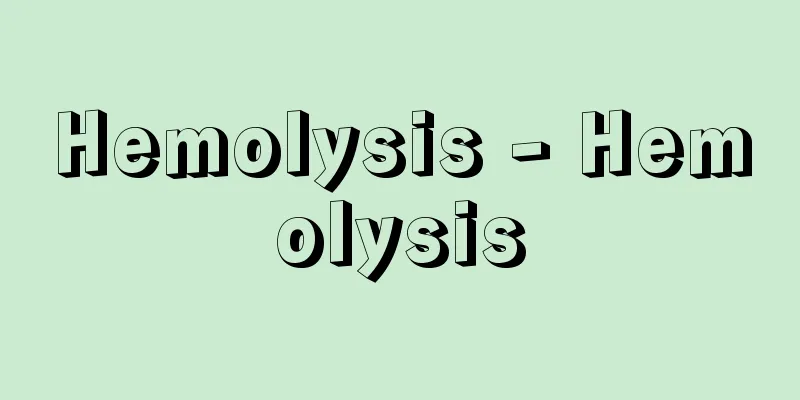Hemolysis - Hemolysis

|
The breakdown of red blood cells in the blood and the release of hemoglobin. In healthy people, red blood cells reach the end of their life 120 days after production, as their metabolism weakens. Then, they lose their characteristic plate-like shape with indentations on both sides, and the spherical red blood cells are captured and destroyed by macrophages, which are mainly found in the spleen. The iron and amino acids that are broken down and released during this process are reused. Porphyrin substances (biliverdin) become indirect bilirubin, pass through the liver, become direct bilirubin, and are excreted in the bile. They are secreted into the duodenum to help digest fat, and are then excreted in the feces and urine. In other words, red blood cells that have reached the end of their life in the body are hemolyzed in macrophages, and all the substances broken down at that time are reused. When red blood cells are taken out of the blood vessels and placed in an isotonic solution with the addition of an anticoagulant to prevent coagulation, they do not disintegrate even after 24 hours, but they swell in a hypotonic solution and shrink and disintegrate in a hypertonic solution, causing hemolysis. When hemolysis occurs, hemoglobin is found in the supernatant obtained by centrifugation. This can be used to measure the osmotic resistance (fragility) of red blood cells. Alternatively, it can be used as a hemolysis test to determine whether there is an abnormality in the glycolysis system in red blood cells by adding glucose and then reacting. If hemolysis occurs in large quantities, hemolytic anemia occurs. In this case, iron and amino acids are reused, but bilirubin becomes excessive and is conjugated in the liver, and since there is a limit to the amount that can be excreted in the bile, it accumulates in the blood as indirect bilirubin. This is hemolytic jaundice. In this case, large amounts of urobilin are found in the urine and feces, but bilirubinuria is not observed. If the hemolysis is mild, indirect bilirubin is metabolized in the liver and jaundice does not occur, and anemia does not occur because it is compensated for by the production of red blood cells. In this case, the life span of red blood cells is measured to determine the hemolysis. [Kenjiro Ito] Source: Shogakukan Encyclopedia Nipponica About Encyclopedia Nipponica Information | Legend |
|
血液中の赤血球が崩壊してヘモグロビンが流出すること。健康人の赤血球は、産生されてから120日経過すると、その代謝が衰弱して寿命が尽きる。そして、両側がへこんだ特有の板状の形が失われ、球状に変化した球状赤血球が、主として脾臓(ひぞう)の中に存在する大貪食(どんしょく)細胞(マクロファージ)にとらえられて破壊される。この際分解されて遊離した鉄、アミノ酸はふたたび利用される。またポルフィリン系物質(ビリベルジン)は間接型ビリルビンとなって肝臓を通り、直接型ビリルビンになって胆汁中に排泄(はいせつ)され、十二指腸に分泌されて脂肪の消化を助けたのち、糞尿(ふんにょう)中に排泄されていく。すなわち、生体内で寿命の尽きた赤血球はマクロファージ内で溶血するが、そのときに分解された物質はすべて再利用される。 血管から体外に取り出された赤血球は、凝固しないように抗凝固剤を加え等張溶液内に入れておくと、24時間経過してもなお崩壊しないが、低張液内では膨化し、高張液内では萎縮(いしゅく)して崩れ、溶血をおこす。溶血をおこすと、遠心沈殿して得た上澄み中にヘモグロビンが認められる。これを利用して、赤血球の浸透圧抵抗(脆弱(ぜいじゃく)性)の大小を測定することができる。あるいは、溶血テストとして用い、ブドウ糖を添加したうえでの反応で、赤血球における解糖系の異常の有無を知ることもできる。溶血が大量におこると溶血性貧血が発生する。この際には、鉄、アミノ酸は再利用されるが、ビリルビンのほうは過剰になって肝臓で抱合され、胆汁に排泄される量も限界があるために、間接型ビリルビンのままで血中にたまってしまう。これが溶血性黄疸(おうだん)である。この場合、尿中、糞中に大量のウロビリン体がみられるが、ビリルビン尿はみられない。溶血が軽いと、間接型ビリルビンは肝臓で代謝されて黄疸はおこらないし、また貧血も赤血球の産生で補われて発生しない。この場合には赤血球の寿命を測定して決める。 [伊藤健次郎] 出典 小学館 日本大百科全書(ニッポニカ)日本大百科全書(ニッポニカ)について 情報 | 凡例 |
>>: Cost of the performance - Yogekiryo
Recommend
Yoshiko Kawada
1895-1970 An actress from the Taisho to early Sho...
Pleurisy - Pleurisy
What is the disease? The pleura is the membrane t...
Myotis ozensis (English spelling) Myotisozensis
…[Yoshiyuki Mizuko]. . . *Some of the terminology...
PFLP-GC (English name) PFLPGC
…Abbreviation for Palestine Liberation Organizati...
Gas station
Gas stations primarily fill automobiles with gasol...
Tomotoki Iseki
?-? A Japanese mathematician in the early Edo per...
Wofatit
...In this case, a membrane that is resistant to ...
Monel metal
A corrosion-resistant alloy containing nickel (Ni6...
OEEC-ENEA - OEEC-ENEA
…It is one of the sub-organizations of the OECD, ...
Aiakos
In Greek legend, he was the king of Phthia in The...
Kitsuki
A district of Izumo City in the central north of ...
juxtaglomerular apparatus (English spelling) juxtaglomerularapparatus
…These epithelial-like cells are collectively cal...
Upper lip - upper lip
〘Noun〙① Upper lip. [Anatomy New Book (1774)]② Part...
Kidachi 100th grade - Kidachi 100th grade
…A small bushy shrub of the Lamiaceae family rela...
Süssmayr, FX (English spelling) SussmayrFX
…A monument to Mozart was erected at Vienna's...









